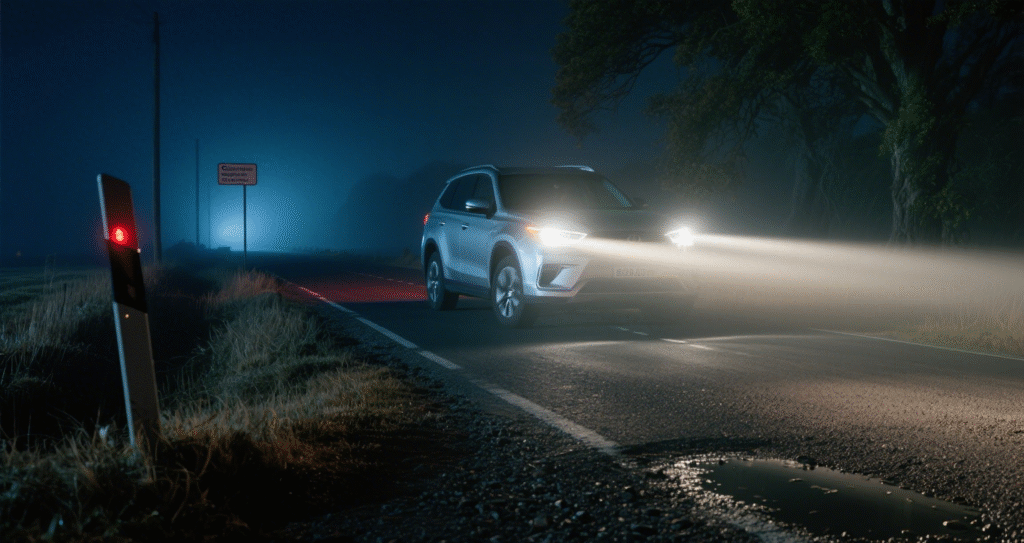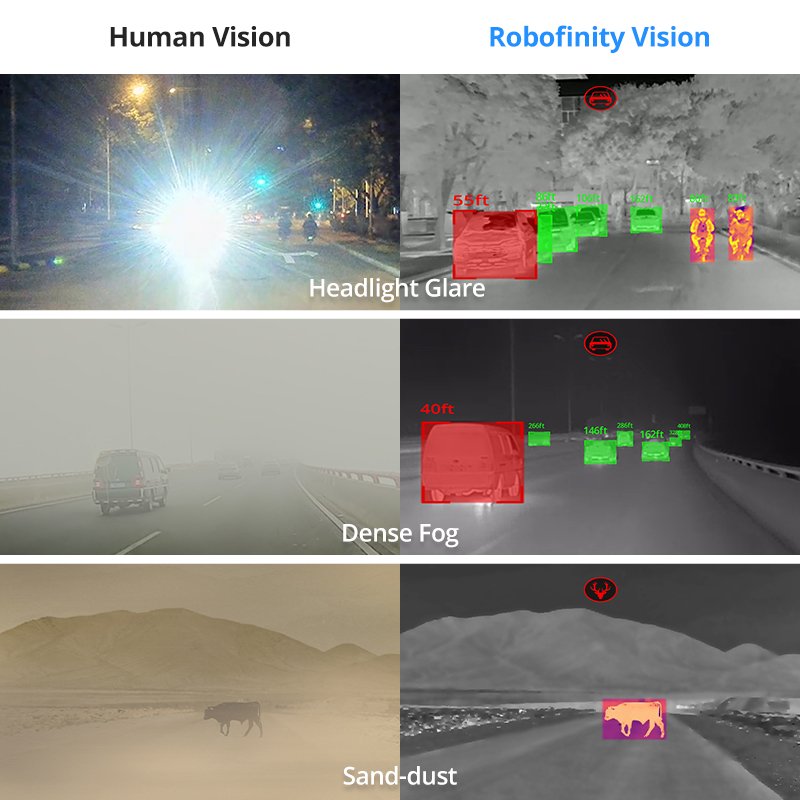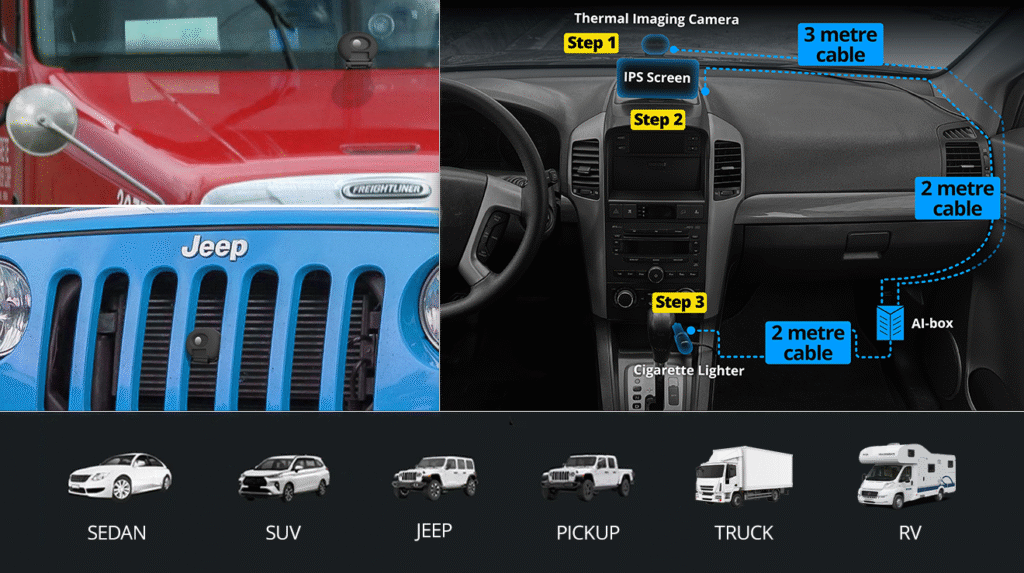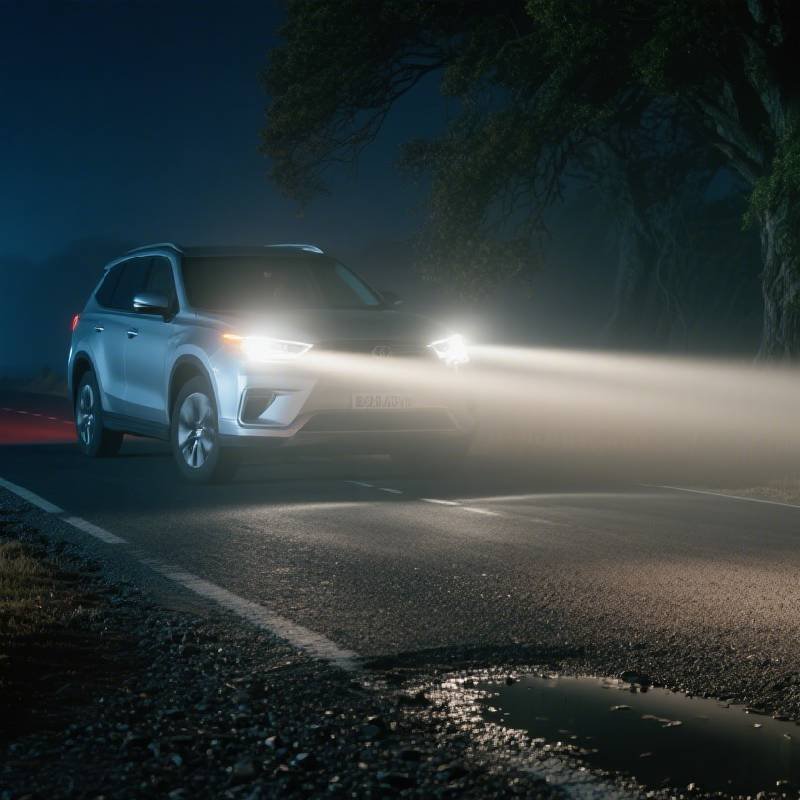Thermal Imaging Camera for Car: How to Choose Over Infrared for Night Safety
Discover the key differences between thermal & infrared! Our ultimate guide reveals why a thermal imaging camera for car is your #1 safety upgrade.
Introduction: The Hidden Dangers of Night Driving and a Tech Solution
Hey drivers! Does night driving often make you nervous? Picture this: you’re cruising down a rural road at night, and suddenly, a deer jumps out from nowhere. You slam on the brakes, your heart pounding. Or maybe, thick fog rolls in, and you can barely see the road ahead. And let’s not forget about blinding headlights from oncoming traffic that leave you seeing spots.
According to data from the National Highway Traffic Safety Administration (NHTSA), the accident rate at night is at least three times higher than that during the day, highlighting the real dangers that threaten lives. These are real dangers that threaten lives.
Your car’s headlights only illuminate a short distance. Standard cameras are almost useless in complete darkness. This is where a thermal imaging camera for car can be a game-changer. Many people have heard of both infrared and thermal cameras and think they work the same way in the dark. But in reality, these two technologies are very different. Choosing the right one boosts your safety; choosing the wrong one can be a waste of money.
Let’s break down the differences in simple terms. This will help you choose the best technology to protect yourself and your passengers.

Basic Concepts: What is an Infrared Camera?
Simply put, an infrared camera works like a special flashlight. It actively emits infrared light and then creates an image by receiving the light that bounces back from objects. It’s like using a flashlight to see in a dark room – you can only see what the light touches.
These cameras have some key traits. First, they need their own infrared light source to work. Without this “flashlight,” they are blind. Second, they can improve images in low-light conditions, but their performance drops significantly in total darkness. Furthermore, they are quite sensitive. Environmental factors like dust, rain, or fog can easily blur the image.
So, where do infrared cameras work well? They are suitable for short-range monitoring, like security cameras at a gate or for indoor use.
However, they are not very reliable for driving safety. Why? Bad weather like rain, fog, or snow scatters infrared light, rendering the camera useless. Their detection range is also limited, usually just a few dozen meters. This isn’t enough distance to react at highway speeds. Also, interference from other infrared sources (like another car’s system) can ruin the image. When considering a thermal night vision camera for car, it’s important to understand these limitations of infrared technology.
Basic Concepts: What is a Thermal Imaging Camera?
A thermal imaging camera for cars works completely differently. It does not emit any light. Instead, it detects the heat (infrared radiation) that all objects and people naturally emit. Anything warmer than absolute zero gives off thermal radiation.
This core functionality provides huge advantages. First, it does not need any external light at all. It works in pitch blackness, giving you superhuman night vision. Second, it has strong penetration capabilities. It can see through rain, fog, haze, and dust, making it a true all-weather technology.
The key thing to understand is that thermal imaging for automotive use shows heat, not light. It displays the temperature differences of objects. This means it can often detect objects that are partially hidden, as long as their heat signature is visible. For example, it can spot an animal hiding behind bushes or a car in the distance through thick fog. This gives you crucial extra time to react.
This technology was first used in military applications. Later, it spread to firefighting, search and rescue, and industrial inspection. Now, technology has advanced and become more affordable. Thermal night vision systems for cars are available to everyday drivers, significantly boosting night driving safety.

Comparison: Five Key Differences Explained Clearly
1. Core Working Principle
The working principle is the most fundamental difference.
- Infrared Cameras use “reflected light.” They act like a flashlight, emitting IR light and creating an image from what reflects back. No emitted light means no image.
- Thermal Imaging Cameras use “radiation detection.” They are passive observers. They detect the heat (infrared radiation) naturally emitted by objects. Ambient light does not affect them. They create an image based on temperature differences. This is the core benefit of thermal imaging camera for car technology.
2. Performance in Different Environments
NHTSA research found that accident rates in bad weather can be over five times higher than on clear days. The performance gap between these cameras is massive in these conditions.
| Condition | Infrared Camera Performance | Thermal Imaging Camera for Car Performance |
|---|---|---|
| Total Darkness | Poor (needs its own light, limited range) | Excellent (does not need any light) |
| Heavy Fog | Very Poor (IR light is scattered by fog) | Good (can detect heat through fog) |
| Rain / Light Snow | Performance drops significantly | Performance largely unaffected |
| Glare (Headlights) | Severely affected (image can be washed out) | Completely unaffected (does not detect visible light) |
As the table shows, thermal imaging camera for car systems are far superior in adapting to complex and changing environments.
3. Detection Range and Accuracy
The effective detection range for infrared technology is usually limited to 50-100 meters. Beyond this, the emitted IR light becomes too weak, and the reflected signal is too poor to form a clear image.
Thermal imaging technology for vehicles is much more powerful. A good thermal imaging camera for car can detect people or animals hundreds of meters away. Professional-grade systems can see even farther. This extra distance is critical for high-speed driving, giving you precious time to react.
Regarding accuracy, thermal sensitivity (NETD) is key. High-end thermal imaging camera for car systems can distinguish temperature differences as small as 0.05°C. This makes it very hard for objects to hide from its “sight.”
4. Target Identification
How these cameras identify objects is also different.
- Infrared Cameras rely mainly on recognizing an object’s shape. If the object is partially obscured (e.g., a person behind a barrier), the camera may fail to identify it.
- Thermal Imaging Cameras identify targets based on their heat signature. This is a big advantage. Even if a person is partially hidden behind bushes or a guardrail, the thermal imaging camera for car can detect their heat. it can also easily distinguish between living things (people, animals) and inanimate objects (like signs) because living things emit a stable heat signature.
5. Cost and Value Analysis
Thermal imaging technology used to be very expensive. Just a few years ago, a thermal night vision system for car could cost tens of thousands of dollars.
However, technology has advanced rapidly, and costs have fallen dramatically. Now, brands like Robofinity offer capable automotive thermal imaging camera products for a fraction of that price.
From a value perspective, a thermal imaging camera for car might have a higher initial cost than an IR camera. But, it provides reliable safety in various challenging conditions. In the long run, this is an excellent value. Avoiding just one serious accident makes the investment worthwhile.
Real-World Applications: Why Drivers Should Care About Thermal Imaging
1. Wildlife Warning Systems
In the U.S., there are 1 to 2 million collisions between vehicles and wildlife every year. These accidents cause approximately 200 deaths and over $1 billion in property damage annually. Most of these collisions happen at night because standard headlights often can’t spot animals hiding near the road.
On roads around Yellowstone National Park, many vehicles installed thermal imaging systems. Statistics showed a more than 70% reduction in wildlife collisions. A thermal imaging camera for car can detect animals on the roadside hundreds of meters away. This gives drivers enough time to slow down or avoid the animal, protecting both the driver and the animal.
2. Pedestrian Detection and Protection
Data shows that pedestrian fatalities at night are three times higher than during the day. Often, drivers don’t see pedestrians until it’s too late to stop.
Thermal imaging technology excels here. It can easily detect pedestrians over 200 meters away—much farther than standard headlights can illuminate. It can accurately distinguish people from other objects. Many modern thermal systems for cars will also sound an alarm when they detect a pedestrian, alerting the driver. This early warning feature is vital on poorly lit urban or rural roads and can save lives.
3. Safety in Bad Weather
In winter 2023, heavy fog on a California highway caused a devastating pileup involving over 30 vehicles. Many drivers simply didn’t see the stopped traffic ahead until it was too late to react.
A thermal imaging camera for car could have made a difference. It can see through fog, clearly displaying the heat signatures of vehicles ahead. Even if visibility is only 10 meters, the camera can detect cars hundreds of meters away. This gives drivers ample time to slow down. Similarly, its performance in rain and snow is far superior to standard visual systems, making it an essential thermal imaging for automotive safety.
4. Glare Reduction
Are you tired of being blinded by oncoming headlights? This glare can cause temporary blindness, leading to dangerous situations in those few seconds.
Thermal imaging technology is immune to this. Since it doesn’t detect visible light, the brightest high beams won’t affect it. The thermal image from your car thermal camera remains clear and stable, allowing you to maintain awareness of the road ahead.
Buying Guide: How to Evaluate an Automotive Thermal Imaging Device
1. Understanding Key Specs
When choosing a thermal imaging camera for car, pay attention to these key metrics:
- Thermal Sensitivity (NETD): This number indicates how well the camera detects small temperature differences. A lower number is better. Look for a value of ≤50mK. Lower values mean the camera can detect more subtle heat signatures, revealing hidden hazards.
- Resolution: This determines image clarity. A minimum resolution of 320×240 is recommended; higher is better. Higher resolution helps you identify objects (person vs. animal) sooner and more accurately.
- Field of View (FOV): A FOV around 40°x30° is often a good balance. Too narrow, and you might miss hazards on your sides. Too wide, and details in the center become less clear.
- Refresh Rate: Look for a rate of 25Hz or higher. This ensures a smooth video feed without blurring or lag, which is critical when driving at high speeds.
Based on our research, Robofinity’s automotive thermal cameras perform well on these key metrics and meet most drivers’ needs.
2. Installation and Ease of Use
Ease of installation is important for many car owners. Look for plug-and-play products you can install yourself without complex vehicle modifications. According to user reviews, some Robofinity models are designed for simple DIY installation.
Consider the power source. Using the 12V cigarette lighter socket is convenient and safe, requiring no wiring changes. Some higher-end models offer hardwiring for a cleaner look, but this usually requires professional installation.
Also, check the software experience. Many thermal cameras connect to a mobile app for viewing, recording, and sharing video. Choose a system with software that is intuitive and responsive.

3. Considering Value for Money
Prices for automotive thermal imaging products vary widely, from a few hundred to several thousand dollars. This difference depends on performance specs and extra features.
Don’t just choose the cheapest or the most expensive option. Think about your typical driving environment. If you often drive on highways or rural roads, prioritize longer detection range and higher resolution.
Also, consider long-term costs. Think about calibration needs, power consumption, and future upgrade possibilities. Based on our testing, Robofinity products offer strong value. For example, for $519, you can get a model with IP67 waterproof rating, low power consumption (≤5W), and support for 128GB memory cards – compared to other brands charging over $800 for similar specs. This makes it an excellent thermal imaging camera for car on a budget.
Conclusion: A Smart Choice for Empowered Safety
Night driving safety is serious. Choosing the right assistive technology can drastically reduce your risk of an accident. Thanks to its unique working principle, thermal imaging outperforms infrared technology in darkness and bad weather. Its ability to work without light, see through obstacles, and detect threats from far away makes it the best choice for night driving.
A thermal imaging camera for car is no longer a luxury item. It’s an affordable safety device for everyday drivers. It provides early warnings for wildlife and pedestrians, offers clear vision in fog and dust storms, and eliminates glare from headlights. It’s like an all-in-one guardian for night driving.
When choosing a thermal imaging camera for car, pay close attention to thermal sensitivity, resolution, and field of view. Also, consider how easy it is to install and its overall value.
While there’s no substitute for safe driving habits, using the right technology adds an extra layer of protection for you and your family. We hope this article helps you make a smart choice for safer night travels. To learn more about specific products, you can check out Robofinity’s official website for detailed model comparisons and customer reviews. You might just find the perfect thermal imaging camera for car for your needs.

